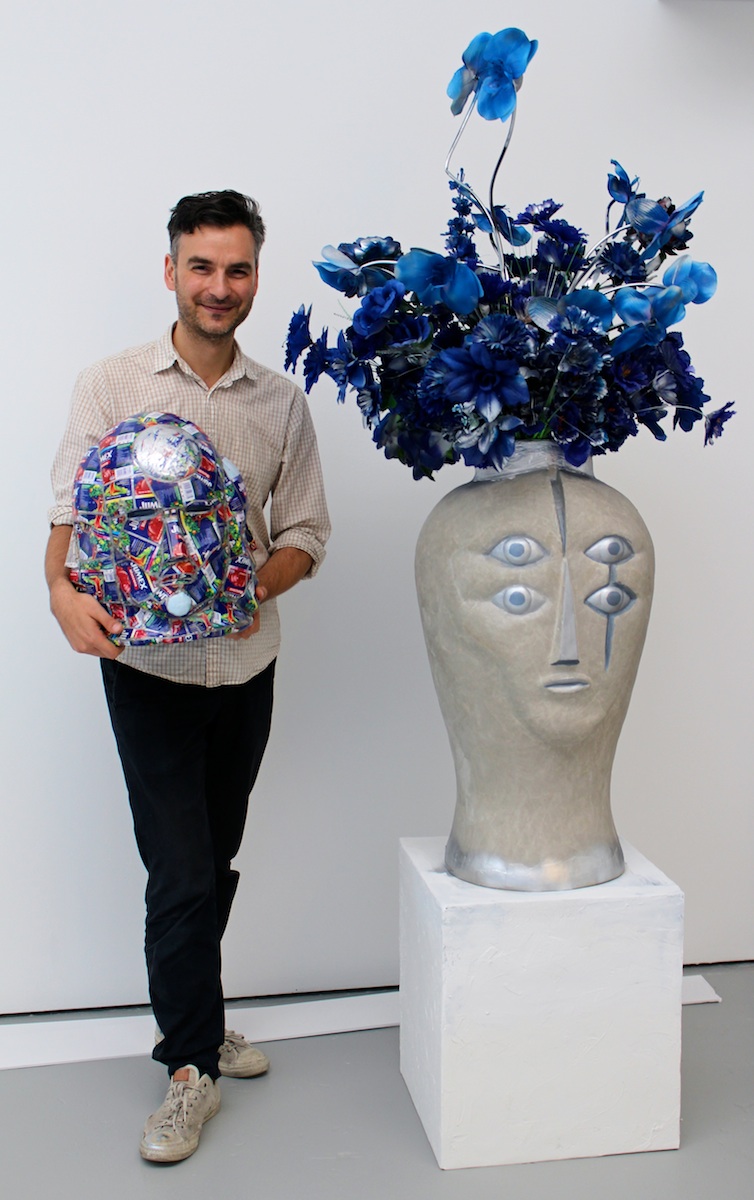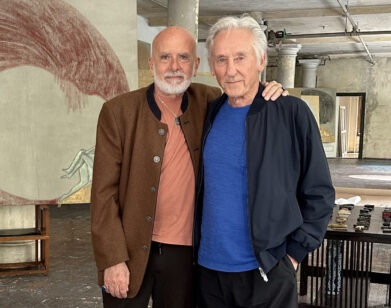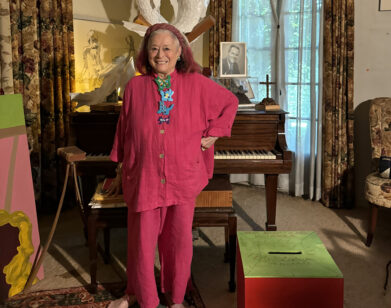Marcel Dzama’s Grandmaster Games
Marcel Dzama’s work to date has been heavily defined by a prolific series of figural drawings produced in graphite, pen and ink, watercolor, and root beer wash. Equal parts macabre and mischievous, these illustrations have created a host of oneiric characters. In this world, guerilla ballerinas can be found both shooting and suckling orgiastic mystery cults, on the same page as anthropomorphic animals and Bauhaus puppets arranged in ceremonial chaos. Bradley Bailey describes one of Dzama’s drawings in the monograph Marcel Dzama: Sower of Dischord as “a grandiose scene of majesty and spectacle, as if the Revelation of John were directed by Busby Berkeley.” While the artist has been working in film for years, it has only been in the past decade that these personalities have jumped from paper to video performance.
In Une Danse des Bouffons (A Jester’s Dance), Dzama conceives of a “Dadaist love story” between artists Marcel Duchamp and Maria Martins. Awakened by a trickster from sculptural stasis as Duchamp’s Étant donnés, Maria (played by both Kim Gordon and Hannelore Knuts) finds Marcel trapped and tortured by chess. She confronts overgrown puppets and quadruple-eyed judges to rescue her lover with the trickster’s assistance (or hindrance). Commissioned by the Toronto International Film Festival in 2013, Une Danse des Bouffons makes its U.S. premiere alongside related two- and three-dimensional work by the artist at David Zwirner Gallery.
Dzama led Interview on a tour of the in-progress installation for his solo exhibition in Chelsea.
RACHEL EGAN: I was first consciously exposed to your work in the form of the exhibition catalog for The Last Winter. I remember it quite vividly—my uncle had given the book to me for Christmas.
DZAMA: Oh—awesome!
EGAN: I’m from Pittsburgh, Pennsylvania, and while the winters are nowhere nearly as harsh as the ones in Canada, it was snowing profusely while I read it. This was around the same time that I saw Guy Maddin’s The Saddest Music in the World. On top of that I was a teenage girl, so the net effect gave me a very romanticized view of Winnipeg and its artists. Back then I thought of you as a draftsman, drawing as a really intimate, insular act, but now there is an outpouring of multimedia—ceramics, dioramas, and film.
DZAMA: I was always doing films, but the ceramics didn’t come until later. I did take ceramics in university, which gave me an appetite for the medium, but I couldn’t figure out what I wanted to do with it yet.
EGAN: When did ceramics start becoming part of your practice?
DZAMA: In 2005 or 2006 when I went to Guadalajara [Mexico]. José Noé Suro had invited me there—he has a foundry and let me do whatever I wanted to do.
EGAN: That reminds me of Georges Ramié facilitating Picasso’s ceramic endeavors in Vallarius, France. Madoura opened up a whole new vocabulary for him.
DZAMA: Definitely! I was inspired to make little figurative characters after seeing lots of local shrines to saints and retablos. I had always loved Joseph Cornell and wanted to do something with dioramas. That’s when I really embraced the impulse.
EGAN: Do you have team assistants that help you with this?
DZAMA: I only designed the chess pieces—they were cast and glazed in Guadalajara. Normally I would go down there to do it myself, but I’ve just had a baby and couldn’t make the trip this time. I much slower with my drawings, too, since I now take more time off. I was actually worried I wouldn’t have enough work for the show! It turns out, though, I could even edit it down a bit.
EGAN: Is that why there’s been a lot of natal imagery popping up in your work? Like the birthing scene in the film and the drawings of fetuses growing inside heads?
DZAMA: Of course! The process of the body changing and making a whole human fascinates me.
EGAN: And these chess pieces—they’re a reference to Marcel Duchamp’s rubber stamp chess set?
DZAMA: Some of them—certainly the knight. The bishop is based on one of his designs that were never actually manufactured. The rest of the chessmen were my attempt to make a more modern-looking set, although the design for the rook is based on a character in my film A Game of Chess and Oscar Schlemmer’s Triadic Ballet. The chess moves you see in Une Danse des Bouffons are from an actual game played by Duchamp when he was representing France in the Olympics. There also images of endgame boards from his book Opposition and Sister Squares Reconciled that he co-wrote with Vitaly Halberstadt.
The whole film is really the story of Duchamp, or rather a false story. It is his Étant donnés come to life to save him from chess and bring him back to art in order to make the Étant donnés. It’s an upside-down, weird fantasy. The video’s timeline doesn’t even work, because the real Étant donnés existed during the time period where Duchamp supposedly quit art entirely for chess, whereas in the film it’s implied he made it post-chess obsession. It’s very messed up.
EGAN: Like Pygmalion’s Galatea being birthed in reverse, coming to life first in order to inspire him to sculpt her. How did you conceive of this narrative? Has it been brewing for some time?
DZAMA: I mainly had the idea of wanting to see both Duchamp’s Étant donnés and Picabia’s Adoration of the Golden Calf come to life. Since I would have needed a budget to make these pieces real, I thought that someone might ask me to direct a music video where I could feature those images. Instead, I was fortunate to have an offer from the Toronto International Film Festival to make a short film.
EGAN: Watching this film through the lens of an artist or an art historian is incredibly fun, because it’s like solving an onscreen picture riddle or a Rubik’s cube. For instance, when the two Maria Martins are in the same frame with chairs worn on top of their heads, I go, “Goya!”
DZAMA: I tried to pick little pieces from things that have deeply influenced my work because I knew I would get very excited to see them come to life. So yes, there’s Goya, Duchamp, Picabia, and Joseph Beuys—
EGAN: —with the cane and the coyote! This might be a bit of a chicken-or-egg question, but do the drawings and storyboards pre-date this film?
DZAMA: The storyboards came first. Some of them illustrate scenes that aren’t even part of the film anymore. The rest of the drawings came after the film.
EGAN: It’s my understanding that the movie will be split from its original black-and-white loop into two parts, tinting one red and the other blue. Since the gallery is being thematically separated by those colors as well, are you isolating the two performances of Maria Martins as well?
DZAMA: Yeah. There’s a Kim Gordon room and that’s the Hannelore Knuts room.
EGAN: Why did you put Kim Gordon in the red room? Any significance?
DZAMA: Actually there kind of was. Maybe it’s just me but I’ve always been kind of fascinated by her.
EGAN: I have a huge crush on her.
DZAMA: I didn’t want to say crush. My wife might read this.
EGAN: It’s okay. I said it!
DZAMA: I’ve always had a crush on her. I think her performance reads very tough and sensual, which I equated as more red than blue. Hannelore’s portrayal feels more dreamy and cool. I didn’t want to say cool, either.
EGAN: I get it though. She’s serving a bit of avant-garde European coolness. I love the choreography as well.
DZAMA: I have Vanessa Walters to thank for that. She’s amazing. I’m not a trained dancer in the slightest, but I can just show her a spidery movement and she translates it into something real. She had the storyboards as well, but I didn’t give her many notes—I knew she would come up with something better than anything I could.
EGAN: Was the Executioner’s Dance filmed in reverse?
DZAMA: It switches back and forth. That was one of my notes, though—everything could and should have the possibility of reversal. Multiple identities and moves. The double mask of the trickster.
EGAN: At points I read the trickster as Maria, even though they coexisted in the same shot.
DZAMA: She is. Duchamp is also the judge.
EGAN: Is the cow a double figure?
DZAMA: He isn’t really a double figure. I was thinking of him as Picabia giving birth to Duchamp to reflect my reading of art history—Duchamp became a far more interesting artist after meeting Picabia.
EGAN: I already want a sequel. What’s next on your plate?
DZAMA: I had an offer of doing a feature so that could be a definite possibility. I’d love to do a short opera or play too. It would have to be ballet heavy!
“MARCEL DZAMA: UNE DANSE DES BOUFFONS (A JESTER’S DANCE)” WILL BE ON VIEW FROM SEPTEMBER 9 THROUGH OCTOBER 25 AT DAVID ZWIRNER GALLERY.







